
January in the vegetable garden is certainly one of the quieter months, however if you’re a keen gardener like me then you’ll be looking at seed catalogues and getting your propagators lined up, eager to get started! There are just a couple of things that can be planted in the garden if the weather allows and if it doesn’t, I retreat to the greenhouse because there are more than a few things to get started in the propagator from the middle of January onwards.
Our winter vegetables are available now, some such as parsnips and swede reach their best after having been exposed to frosts and winter salad crops can still be harvested from the greenhouse or from under a cloche.
Whilst there isn’t much to plant outside this month and for much of the month the ground is either frozen or waterlogged, if you can get around your beds easily without treading on the soil (and compacting it) then you might consider using cloches to dry out and warm the soil.
In my Jobs for January you will see I put my cloches out now and cover some beds with clear plastic to dry out and warm raised beds so I can get an early start next month.
Shallots
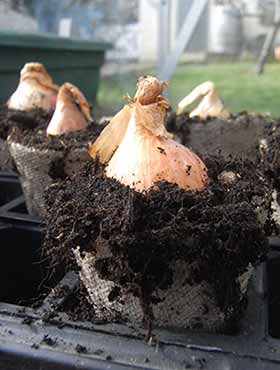
Traditionally they say shallots should be planted on the shortest day of the year in December. Most garden centres don’t stock shallots at this time, so unless you order them on-line, you may need to wait until they appear in the garden centres in mid-January.
If there is a lot of wet weather or the ground is frozen in January, I will leave planting until early February or if I’m enthusiastic, I will get them started in coir pots ready to pop in the ground when the weather permits. This has a couple of added bonuses, firstly, you can hoe weeds that have started developing before planting them out, which certainly gives them a head start and kills off the first round of weed seeds on the bed but secondly it also stops the birds from pulling them out or them popping out of the ground as their roots push downwards so you won’t need to replant them.
So your greenhouse or polytunnel was cleared before winter and the glass / plastic was washed to allow as much sunlight in as possible and now the New Year has passed, you’re itching to get something started. Well this is where the first early sowings can be started, usually in a propagator because temperatures in the greenhouse will still fall below freezing at night unless you provide heat.
Check your electricity supply for propagators is working and since you had it installed correctly and didn’t just run an extension lead from a socket in the house, there is an RCD unit that needs testing… Right?
I have tried keeping plants heated and unheated over the winter months and I only tend to use heat now when I really have to which is usually in the early spring when I have the greenhouses full of young plants waiting for the weather to warm up.
During January (and early February) of course it’s just the propagators that are in use, there is no need for me to provide heat in the greenhouse yet.
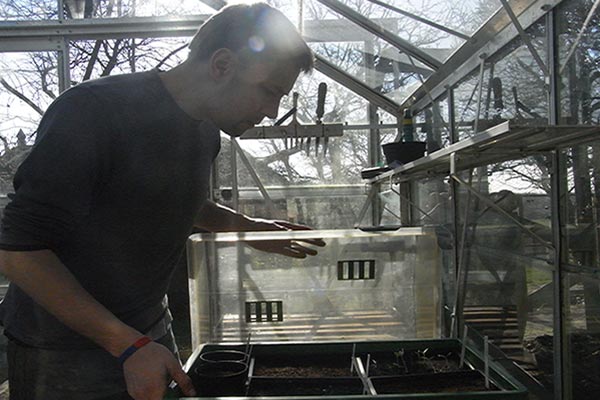
The main ‘problem’ in January is light levels. If you use a propagator, you can produce the correct temperature for germination, however without sufficient light, seedlings will grow tall and etiolated.
Unless you use artificial lights for growing then you need to ensure your greenhouse glass is really clean and make sure any seeds you do grow can catch the sunlight throughout the day (which isn’t easy considering the sun is so low in the sky at this time of year). Some seedlings can also be buried up to their seed leaves when transplanting which certainly helps.
If you have enough space in your greenhouse for staged sowings of tomato plants then you could sow a few tomato seeds in a propagator (at 20-22C) from mid January until mid May.
Once they are big enough to transplant, put them into their own 3″ pots and continue to grow them in the propagator but at a slightly cooler temperature of 18C. As they reach the lid, they can be grown on staging in the greenhouse but you will either need to bring them in to the house at night, or provide heat in the greenhouse to keep the night-time temperature above 5C.
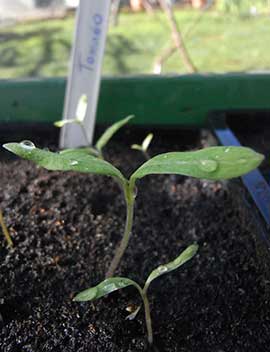
The varieties of cabbage available is diverse so it is possible to have fresh cabbages from your garden during any month of the year. All year round varieties of cabbages can be sown at the end of the month in a propagator (set to a soil temperature of 20-25C). Germination takes 4 -7 days and after 10-14 days, they can be buried up to their seed leaves (which won’t hurt them and creates a stronger plant from tall seedlings) in a 3” pot. Grow them on in cooler conditions until plants have filled the pot and are large enough to be transplanted 30-40cm apart in fertile soil. Cabbages require high levels of nitrogen so ground that has had manure added over the autumn / winter is ideal. Fleece or a cloche can be used to protect from frosts but also birds such as pigeons or why not grow a few on in the corner of a greenhouse? Varieties to try are Pixie (fast to mature and produces good solid heads), Hispi (another cabbage that’s quick to mature, producing good pointed heads), and Duncan (which produces pointed heads and will last well into the summer).
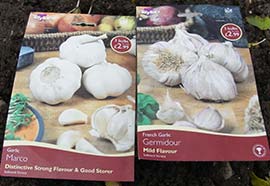
If you didn’t plant broad beans in the Autumn then ‘Aquadulce Claudia’ broad beans can be planted now in pots (5cm deep). Leave them in the greenhouse and they should be ready for a spring planting outside under cloches which can be used until they outgrow them.
A common pest of broad beans is the aphid blackfly. Companion planting with the herb Summer Savory can help deter them. Sow it in February into seed trays in a propagator and pot on. It should be of sufficient size for planting out with your broad beans and should reach 6″ by May (I put one plant in the row to every five broad bean plants). As well as being a good companion plant, it is also good to use when cooking the broad beans to give them excellent flavour.
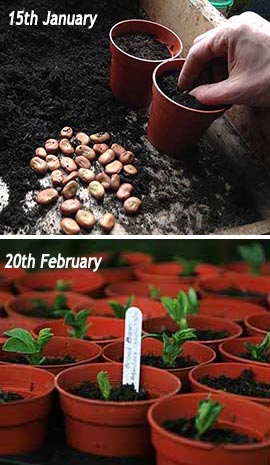
Leeks can be sown under glass now for hardening off and transplanting later into the garden.
Autumn Giant 2 – Povite is one variety I’ve had a lot of success with. They stands well over the winter months and are resistant to bolting. Sowing them now should provide leeks big enough to start harvesting in early September through to February or even March. When planting out use a bed that had plenty of well-rotted manure dug-in last year.
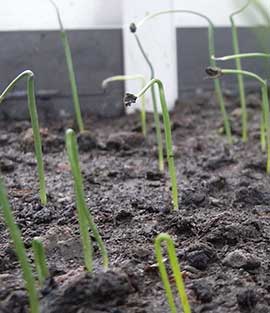
Here are my gardening jobs for January:
Seed potatoes usually appear in garden centres half way through the month or they can be ordered on-line and delivered directly to your door.
If you live in the wetter areas of the U.K. you would be wise to choose blight resistant varieties. Bedfordshire is usually very dry so I don’t worry too much and try to grow varieties that I simply can’t find in the shops. Pink Fir Apple is one of my favourites. It is a heritage variety that is over a century old and best described as a knobbly potato that has a deliciously nutty flavour. They stay firm when boiled and are an ideal, flavoursome potato for salads.
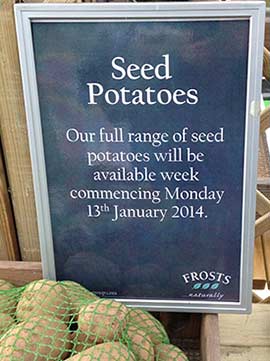
A cloche, or plastic raised off the ground so the air can flow will allow your soil to dry out and warm. Soil temperature is critical for seeds to germinate and cloches are useful for gardeners that want to get an early start or protect plants from extreme weather at the beginning of the growing season. Sandy soils are free draining and warm quickly as they dry out. Heavy clay soils hold moisture for longer so take longer to dry out and warm.
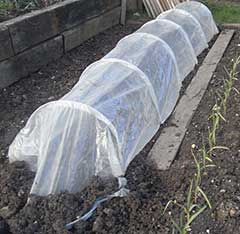
Check fruit and vegetables you have in the winter store for signs of rot so that it doesn’t spread, spoiling the rest in the store.
There are a number of seed catalogues selling seeds so if you plan to order this way, then now is a good time to place your order.
Rhubarb is one of the easiest things to grow. An upside down bucket, or a rhubarb forcer can be used to produce some delicious pink sticks of rhubarb weeks before it would normally be ready.
Another method to get an early crop is to Steep Rhubarb. Wooden frames are built up around the tubers, eventually to about 18 inches in height. They are filled with leaves / straw or other well drained organic material that will later rot down and feed the plant. Stalks are picked by putting your hand into the mulch to the base of the stem and pulled in the usual way.
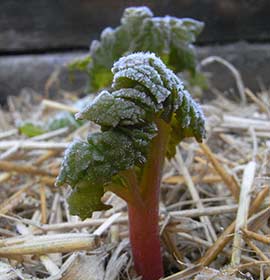
Garden tools with wooden handles can be cleaned, lightly sanded to remove splinters and then treated with Linseed oil before being stored until the spring. This will protect and preserve the wood for the gardening year ahead, ensuring your tools last many years.
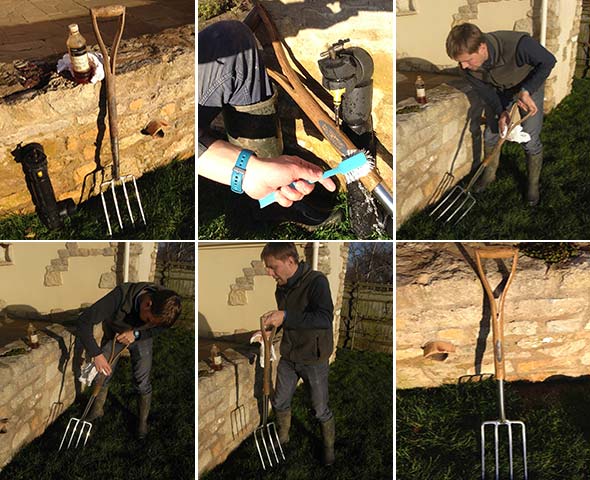
Fruit trees and bushes are dormant over the winter months, so it’s the perfect time to prune, move and plant. I try to get most of this done before January because you just don’t know what the weather will be like. If the ground is frozen nothing can be planted and if it’s waterlogged, you shouldn’t be treading on the soil and digging is impossible on our clay soils! If you’re lucky and have reasonable weather then it’s time to crack on and get these jobs done in the fruit garden.
It is best to prune apple and pear trees whilst they are dormant during the winter months. Both apple and pear trees perform better with regular (annual) pruning once they start fruiting.
Don’t be tempted to prune fruit trees with stone fruits (e.g. cherries, apricots, plums) since it will make them susceptible to silver leaf disease. This fungus infects the tree through wounds such as those caused by pruning and causes a silvering of the leaves and eventually death of the whole branch.
I keep pruning simple: Remove any suckers that have appeared and then cut off dead or diseased branches, cut these flush and back to the main branch. Next, remove branches that cross one another. Finally, reduce the length of branches by pruning back to an established branch or an outward facing bud. Try to keep the centre of the tree open by removing branches that are growing across the centre.
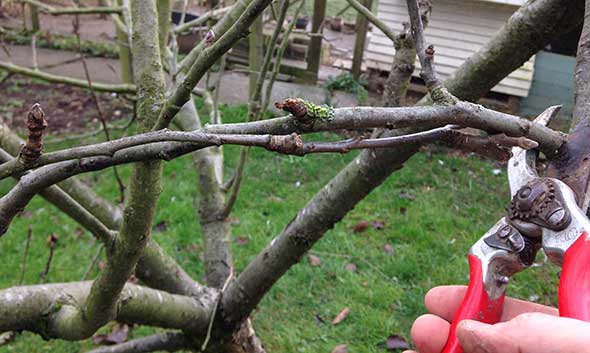
If you haven’t already pruned these in November or December then get on and prune them now. Bushes grow better if light and air are allowed to circulate amongst the branches so remove dead or diseased branches and any that are touching the ground and then remove branches that are crowding the centre, leaving around five main branches.
Taking hardwood cuttings isn’t difficult. If you haven’t already taken cuttings then you can still do so now. If you’re not sure how to do this, then I provided a step-by-step guide showing you how to prune black currant bushes in November’s In the Fruit Garden.
Raspberries cost a small fortune in the shops, yet if you have a sunny, free draining site, they can be grown with ease from bare root canes now.
Pot grown raspberry canes can be bought year-round but they will cost you more, although look carefully at what you’re getting as some have more than one cane to a pot so do check the number of canes before buying.
Different varieties of raspberry cane will provide fruit at different times of the year so you can have a continuous harvest from early summer through to Autumn.
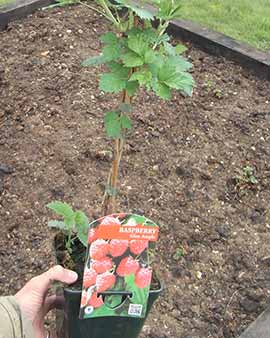
The winter vegetables are in good supply at this time of year so there is no shortage of things to eat from the garden. Freezing weather can cause problems so I usually loosen some vegetables in the ground as I go and then before we need them, cover the ground with an inch or two of straw or double layer of fleece to stop the ground freezing around them. Whilst some vegetables can be lifted and stored in dry sand or compost (carrots, swede and celeriac are what I usually lift and store), others such as parsnips taste better after they have been subjected to a frost so should be left in the ground.
Don’t forget there are still rabbits, deer and pigeons about that are looking for food so make sure brassicas and other susceptible vegetables are covered with nets.
Brussels Sprouts are coming to an end by the end of this month but are still a welcome vegetable for our Sunday roasts.
Winter radishes that were left in the ground can be dug up as required if you cover them with fleece or straw during frosty weather.
Winter salad crops sown under a cloche or in the greenhouse in late summer can still be harvested gradually.
Some lettuce such as Winter Density or Arctic King will also withstand freezing weather (to a point) which is good because I often forget to cover the outdoor grown lettuce back up after picking lettuce almost daily.
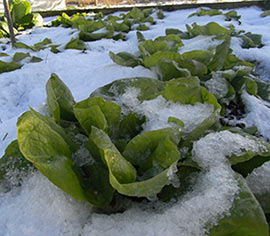
Continue to pull leeks as required. These will withstand harsh weather so there is no hurry to use them up whilst the weather is cold. The main concern is being able to get them out of the ground if it is frozen.
During a mild spell, loosen the soil around a few of them, then cover the soil with a layer of straw or fleece. You can move this along as you use them.
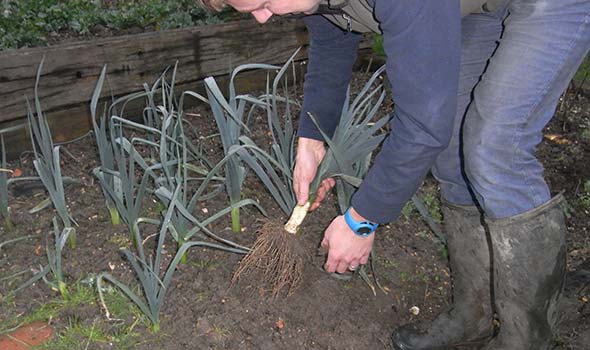
After having had a frost or two on them, parsnips sweeten up and are ready for harvest.
Like leeks, parsnips can be left in the ground and pulled out as required, providing the ground isn’t too hard with frost.
Land cress is also called American cress and is hardy enough to withstand our winters. It is a watercress substitute and rich in vitamins, iron and calcium. I don’t grow much of it here because it can be rather spicy / peppery and we’re not overly keen on the taste.
These always amaze me. They have no relation to Jerusalem, and aren’t a type of artichoke but a tuber. Jamie Oliver called them a “rough and ready potato” and whilst the flavour is stronger than a potato, they can be used in much the same way. We add a couple when making mashed potato, roast them with garlic and rosemary with potatoes and make a huge supply of soup which has a curry powder in it to give it a good twang. Jerusalem Artichokes can be left in the ground and dug up as required.
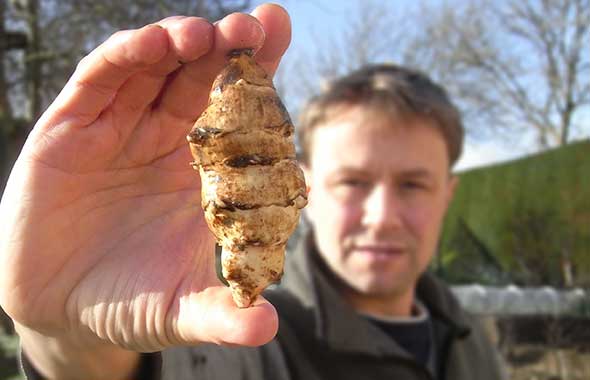
You can continue to harvest swede until about March or April if the weather is still cold. Once spring arrives, I lift the remaining swedes and store them.
To store swedes, remove the leaves and put them in boxes (which must be breathable, wood is ideal, don’t use plastic) filled with dry sand. Make sure they don’t touch one another. Store boxes in a cool dark place. You can keep them for 6-8 weeks like this.
January King is my favourite winter cabbage, it has great taste and steamed still stays crunchy and what an appropriately named variety it is for this month! This cabbage is incredibly hardy and even severe frosts don’t seem to bother it in the slightest so harvest them as you need them. Do remember to cover up your crop with nets to stop pigeons them getting a free lunch.
We eat a lot of kale here, it is packed full of goodness, especially vitamins K, A and C. There is research suggesting steamed kale can lower cholesterol levels and reduce the risk of certain kinds of Cancer as well as having antioxidant and anti-inflammatory benefits. My wife uses it in raw green juices although I find the taste of these a little harsh!
Kale is very hardy and can be picked gradually over the winter which encourages new growth for a second (smaller) picking of fresh leaves.

I don’t usually mention herbs in my ‘What to Harvest’ list because they are usually ‘always there’ in the spring and summer months but at this time of year, there isn’t much left to eat on the herb bed but parsley will still keep on producing until it runs to seed when the weather warms up.
Well, that’s it for January in my garden. I’d love to have some feedback from you below, especially if you have some tips, or perhaps other jobs you do in your vegetable garden?
If you liked this article, I would of course appreciate you sharing it. Thanks!
